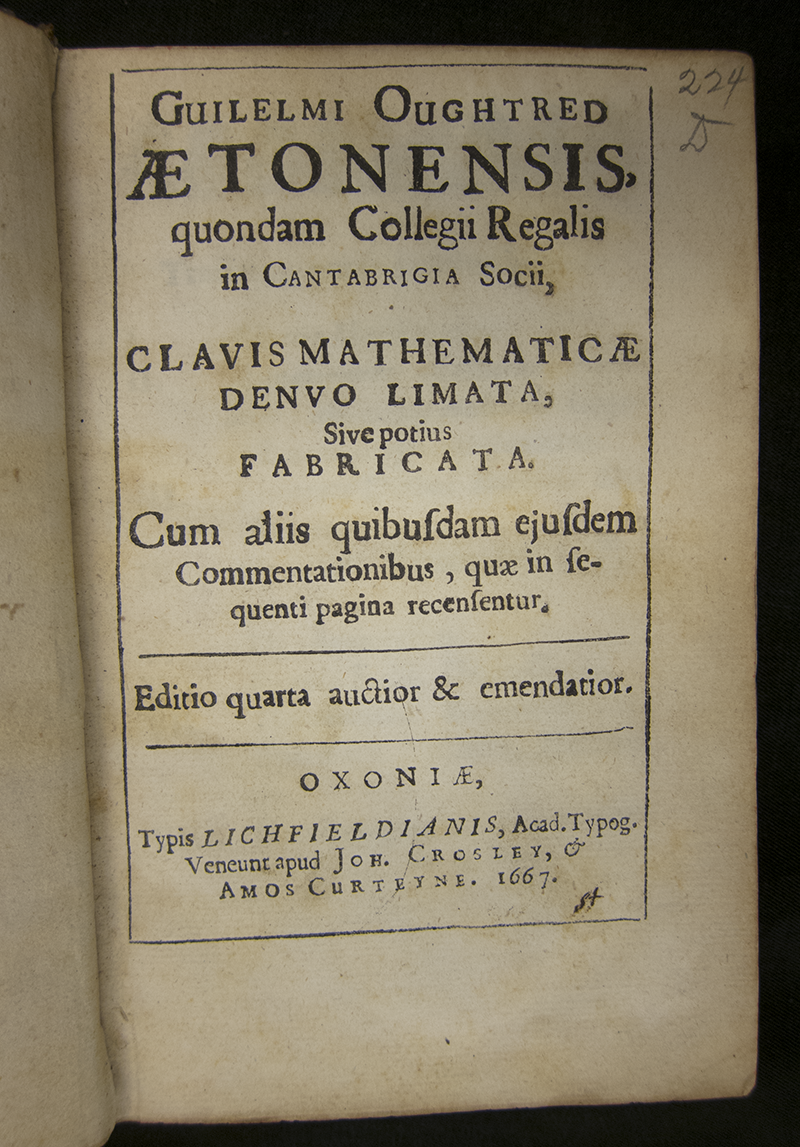- About MAA
- Membership
- MAA Publications
- Periodicals
- Blogs
- MAA Book Series
- MAA Press (an imprint of the AMS)
- MAA Notes
- MAA Reviews
- Mathematical Communication
- Information for Libraries
- Author Resources
- Advertise with MAA
- Meetings
- Competitions
- Programs
- Communities
- MAA Sections
- SIGMAA
- MAA Connect
- Students
- MAA Awards
- Awards Booklets
- Writing Awards
- Teaching Awards
- Service Awards
- Research Awards
- Lecture Awards
- Putnam Competition Individual and Team Winners
- D. E. Shaw Group AMC 8 Awards & Certificates
- Maryam Mirzakhani AMC 10 A Awards & Certificates
- Two Sigma AMC 10 B Awards & Certificates
- Jane Street AMC 12 A Awards & Certificates
- Akamai AMC 12 B Awards & Certificates
- High School Teachers
- News
You are here
Mathematical Treasure: Oughtred's Clavis Mathematicae

Title page of the 1667 edition of William Oughtred's Clavis Mathematicae
(The Key to Mathematics), originally published in 1631.
William Oughtred (1574–1660) was a minister of the Church of England by training but a self-taught mathematician by avocation. While tutoring the son of the Earl of Arundel, he compiled a small booklet on mathematics to assist his student with his learning. When published as a book under the title Clavis Mathematicae (The Key to Mathematics) in 1631, it became very popular and eventually went through seven editions, the last published in 1702. Oughtred’s book, noted for its conciseness and use of symbolism, made its author a mathematician of renown. In the solving of problems, he stressed the use of an “analytic art” whereby “taking the thing sought as known, we find what we seek.” To a modern reader such a comment may seem confused but what Oughtred was urging was a deductive approach to problem solving. The title page of the 1667 edition is shown above.

Handwritten table of contents for the volume in which this 1667 edition of Oughtred's Clavis Mathematicae was bound.
Annotations on a pre-title page in a fine hand provide the reader with a list of “Works in this Volume” (or table of contents) and a brief biography of William Oughtred. Here it is seen that the book actually contains five works by Oughtred; besides Clavis, there are contributions published in 1662, 1663, and 1677. It was not unusual at this time for several publications to be bound together into a single volume.

Long division in Oughtred's Clavis Mathematicae.
Here on page 13 of Clavis, Oughtred provided illustrations of long division by considering the quotient 187135075 ÷ 297. The method he employed was a hybrid technique combining the downward form popular today with the scratch method of the “galley” algorithm. The two examples of the same problem, the top one with the divisor at the left of the dividend and the second with the divisor placed below the dividend, provide the same correct answer, 630084 127/297. The reader should work his or her way through these examples to better understand the steps within each process.
These three images are presented courtesy of Archives and Special Collections, Dickinson College, Carlisle, Pennsylvania. You may use them in your classroom and/or for private study; for all other purposes, please obtain permission from Archives and Special Collections, Waidner-Spahr Library, Dickinson College, Carlisle, PA.
For more information about William Oughtred:
The Galileo Project biography of William Oughtred, by Richard S. Westfall.
MacTutor History of Mathematics Archive biography of William Oughtred, by J. J. O’Connor and E. F. Robertson.
Frank J. Swetz (The Pennsylvania State University), "Mathematical Treasure: Oughtred's Clavis Mathematicae," Convergence (February 2014)




